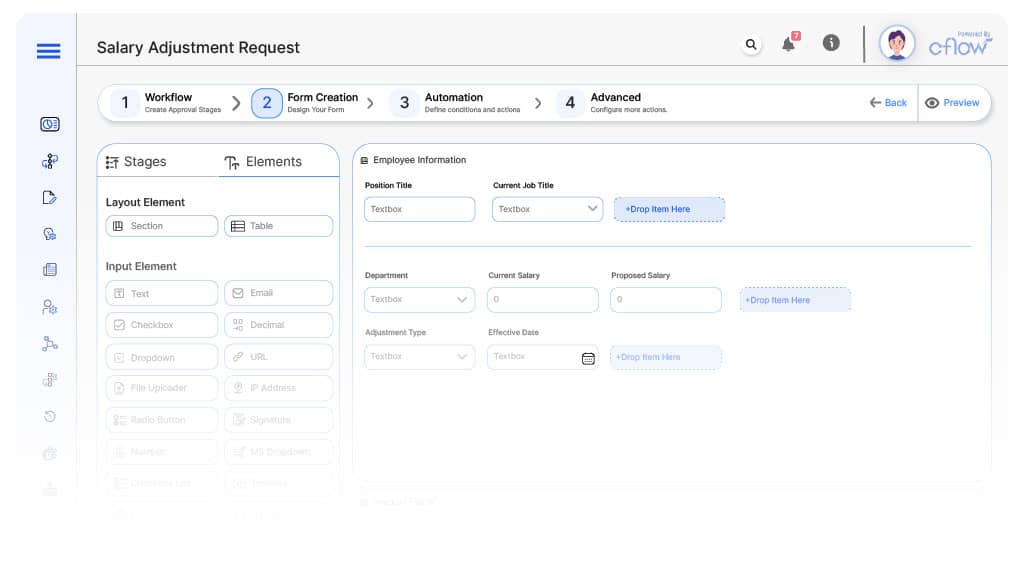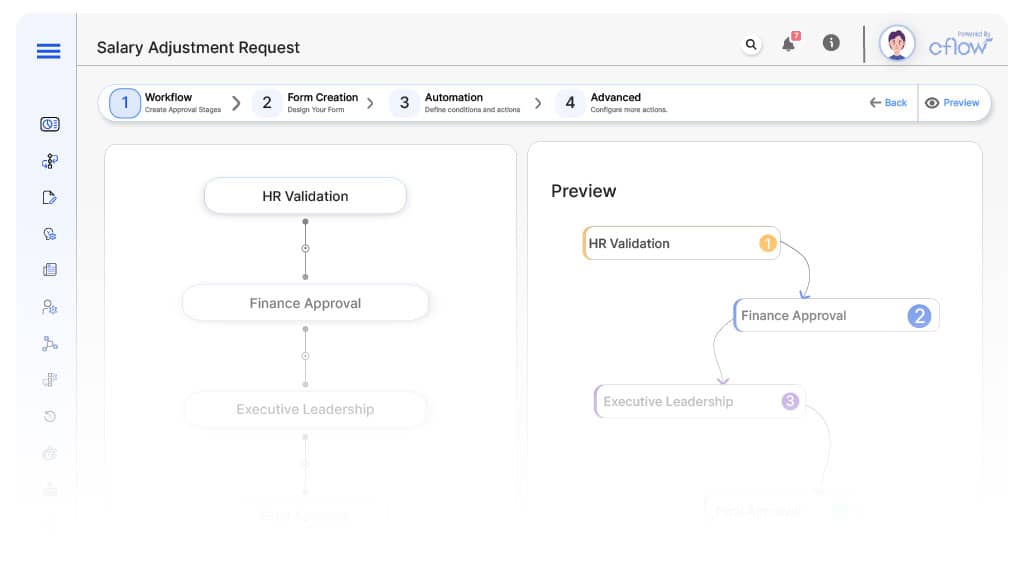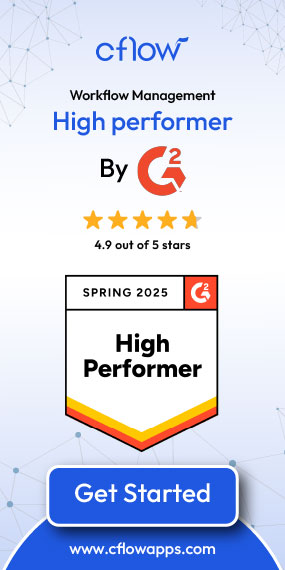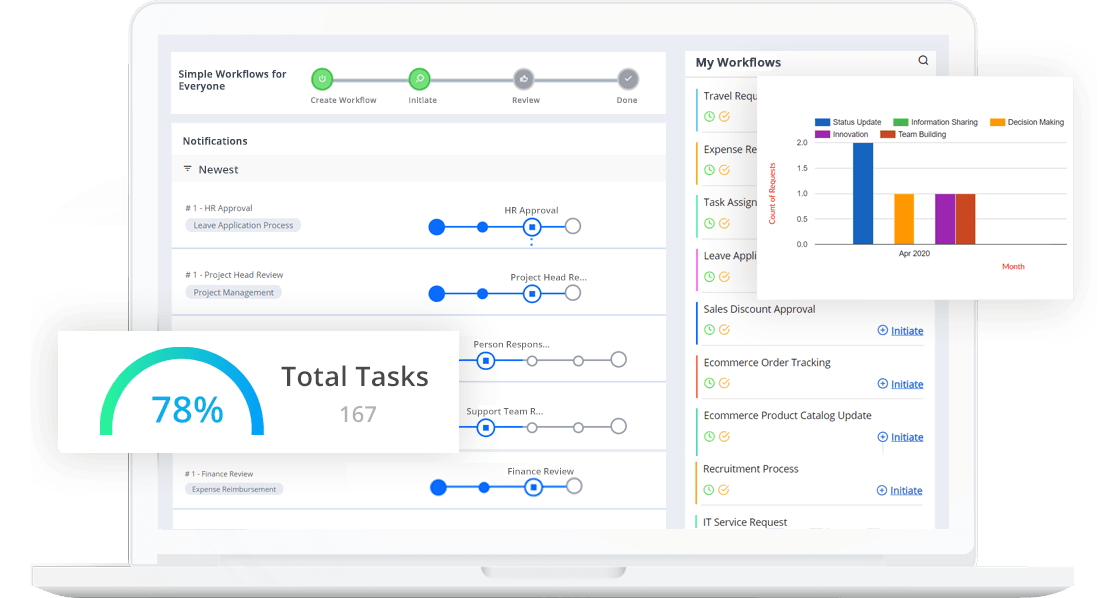- Cflow
- Salary Adjustment Request Automation
Salary Adjustment Request Automation
Learn how Cflow streamlines Salary Adjustment Request Process for HR teams at mid-sized organizations, step-by-step workflow, roles, form fields, approval logic, and real examples.

Clow Team

Salary adjustment requests are highly sensitive HR workflows tied to employee satisfaction, retention, budget compliance, and legal considerations. Without automation, these requests often face delays, lack documentation, or result in payroll discrepancies. Recent industry research shows that 32% of organizations report salary adjustment delays due to complex approval hierarchies and missing documentation.
Coordinating salary change requests across managers, HR, finance, and leadership is challenging when managed manually. This guide walks you through exactly how Cflow automates Salary Adjustment Request Process, from request initiation to final payroll update.
Coordinating salary change requests across managers, HR, finance, and leadership is challenging when managed manually. This guide walks you through exactly how Cflow automates Salary Adjustment Request Process, from request initiation to final payroll update.
Table of Contents
What Is Salary Adjustment Request Process?
The Salary Adjustment Request Process governs how pay increases, market corrections, role reclassifications, or equity adjustments are submitted, validated, and approved. It ensures compensation changes follow internal guidelines, budget approvals, and audit requirements before payroll adjustments occur.
Think of salary adjustments like financial transactions, each requires proper validation, budget checks, executive authorization, and clear audit trails. Without structure, errors, inequities, or compliance failures occur.
Recent industry research shows that automating salary adjustments can reduce processing time by 40% and improve audit readiness by 60%.
Think of salary adjustments like financial transactions, each requires proper validation, budget checks, executive authorization, and clear audit trails. Without structure, errors, inequities, or compliance failures occur.
Recent industry research shows that automating salary adjustments can reduce processing time by 40% and improve audit readiness by 60%.
Why Salary Adjustment Process Is Important for HR Teams
Budget Compliance
Verifies increases fit within approved compensation budgets
Internal Equity
Prevents favoritism and ensures adjustments align with salary bands.
Legal & Audit Protection
Documents rationale and approval trails for future audits.
Leadership Visibility
Keeps executives informed of payroll impacts and workforce costs.
Try Cflow for free, no credit card needed
Key Benefits of Automating Salary Adjustment Request Process with Cflow
- Centralized Adjustment Portal : Cflow provides a single system where all salary change requests are submitted, reviewed, and tracked in real-time. Managers initiate requests, while HR, Finance, and Executives monitor pending approvals and ensure transparency throughout the process.
- Dynamic Eligibility & Validation Rules : Cflow automatically applies company policies regarding tenure, recent performance, salary band ceilings, and market benchmarks. Ineligible or non-compliant requests are blocked or flagged, ensuring HR only processes valid requests.
- Multi-Level Approval Routing : Salary adjustment requests automatically route to managers, HR, finance, and executives based on amount, employee level, and policy thresholds. Cflow’s conditional workflows ensure appropriate oversight for both minor adjustments and significant pay increases.
- Real-Time Notifications & Escalations : Automated alerts keep approvals on track. Escalation rules notify HR and leadership if requests stall at any stage, reducing delays while maintaining approval rigor.
- Policy Compliance Enforcement : Cflow enforces salary band restrictions, maximum increase limits, tenure rules, and required justification fields. Requests violating policies require additional leadership sign-off or are automatically blocked, ensuring consistency and fairness across departments.
- Audit Trail & Documentation : Every salary change decision is fully timestamped with comments, approvals, and rationale captured for audit purposes. HR can instantly generate historical reports for internal audits, legal reviews, or regulatory compliance.
- Mobile Accessibility : Managers and executives can review and approve salary adjustments from any device. Cflow’s mobile-optimized interface ensures requests never bottleneck due to travel or device availability, keeping workflows on track.
Get the best value for money with Cflow
User Roles & Permissions
Initiating Manager
- Responsibilities: Submit salary adjustment request, provide justification.
- Cflow Permission Level: Submit Form.
- Mapping: “Managers” group.
HR Officer
- Responsibilities: Validate policy compliance, salary bands, equity considerations.
- Cflow Permission Level: Approve/Reject.
- Mapping: “HR Team” group.
Finance Approver
- Responsibilities: Confirm budget availability for adjustment.
- Cflow Permission Level: Approve/Reject.
- Mapping: “Finance Team” group.
Executive Leadership
- Responsibilities: Approve adjustments exceeding certain thresholds or for senior positions.
- Cflow Permission Level: Approve/Reject.
- Mapping: “Executive Team” group.
Payroll Admin
- Responsibilities: Execute approved salary adjustments in payroll system.
- Cflow Permission Level: Task Owner.
- Mapping: “Payroll Team” group.
Compliance Auditor
- Responsibilities: Review salary adjustment records.
- Cflow Permission Level: View Only.
- Mapping: “Compliance” group.
Discover why teams choose Cflow
Form Design & Field Definitions

Field Label: Salary Adjustment Request ID
- Type: Autonumber
- Auto-Populate: Generated on submission.
Field Label: Employee Name
- Type: Text (Read-only)
- Auto-Populate: Pulled from HRIS.
Field Label: Current Job Title
- Type: Text
- Auto-Populate: From profile.
Field Label: Department
- Type: Dropdown
- Auto-Populate: From profile.
Field Label: Current Salary
- Type: Numeric Field
- Auto-Populate: From HRIS.
Field Label: Proposed Salary
- Type: Numeric Field
- Logic/Rules: Compared against salary bands.
Field Label: Adjustment Type
- Type: Dropdown (Merit Increase, Market Adjustment, Promotion, Equity Correction)
- Logic/Rules: Drives routing.
Field Label: Effective Date
- Type: Date Picker
- Logic/Rules: Cannot precede current date.
Field Label: Justification Comments
- Type: Text Area
- Logic/Rules: Mandatory for managers.
Field Label: HR Validation Notes
- Type: Text Area
- Logic/Rules: Required for HR.
Field Label: Finance Budget Notes
- Type: Text Area
- Logic/Rules: Required for Finance.
Field Label: Executive Comments
- Type: Text Area
- Logic/Rules: Required for executive approvals.
Field Label: Payroll Update Confirmation
- Type: Checkbox
- Logic/Rules: Payroll marks as complete.
Transform your Workflow with AI fusion
Approval Flow & Routing Logic

Submission → HR Validation
- Status Name: Pending HR Validation
- Notification Template: “Hi HR, salary adjustment request submitted for {Employee}. Please review.”
- On Approve: Moves to Finance.
- On Reject: Returns to Manager.
- Escalation: Reminder after 2 days.
HR → Finance Approval
- Status Name: Pending Finance Review
- Notification Template: “Hi Finance, salary adjustment request for {Employee} requires budget validation.”
- On Approve: Moves to Executive Review (if applicable).
- On Reject: Returns to HR.
- Escalation: Reminder after 2 days.
Finance → Executive Leadership (Conditional)
- Status Name: Pending Executive Approval
- Notification Template: “Hi Leadership, salary adjustment request for {Employee} exceeds threshold. Approval required.”
- On Approve: Moves to Payroll.
- On Reject: Returns to HR.
- Escalation: Reminder after 2 days.
Executive → Payroll Processing
- Status Name: Pending Payroll Update
- Notification Template: “Hi Payroll, approved salary change for {Employee} ready for processing.”
- On Complete: Moves to Adjustment Finalized.
Final → Adjustment Finalized
- Status Name: Adjustment Completed
- Notification Template: “Salary adjustment for {Employee} successfully processed and archived.”
Transform your AI-powered approvals
Implementation Steps in Cflow
Create a new workflow
Go to Cflow → Workflows → New → Name “Salary Adjustment Request Automation.
Design the form
Add fields from Form Design & Field Definitions. Set conditional logic.
Set up User Roles/Groups
Create: “Managers,” “HR Team,” “Finance Team,” “Executive Team,” “Payroll Team,” “Compliance
Build the process flow diagram
Submission → HR → Finance → Executive → Payroll → Completed.
Configure notifications
Apply templates and escalations per Approval Flow.
Set conditional logic
Adjustment amounts drive executive review triggers.
Save and publish workflow
Activate process.
Test with a sample request
Submit test salary adjustment; validate routing and notifications.
Adjust logic if needed
Fine-tune fields and escalation rules.
Go live
Assign real users; train HR, Managers, Finance, and Payroll.
Example Journey: Sarah’s Market Adjustment
Sarah’s manager submits market adjustment effective September 1st. Cflow assigns ID SAL-2025-062. HR validates policy compliance, Finance confirms budget alignment, Executive approves due to salary band threshold, Payroll processes update. Full audit trail archived.
FAQ's
How long does it take to set up Salary Adjustment Process in Cflow?
Setup typically completes within 3–5 business days.
Can adjustment amounts automatically trigger executive reviews?
Yes. Cflow can integrate with workforce planning systems to validate headcount before submission.
Does Cflow integrate with HRIS and payroll systems?
Absolutely. Cflow integrates with HRIS for salary data and payroll systems for execution.
Is the audit trail fully automated?
Yes. Every request, comment, and approval is timestamped and archived automatically.
Unleash the full potential of your AI-powered Workflow

Explore More Process Automations
Employee Transfer Approval Automation
June 16, 2025
Cflow Process Process Automation Employee Transfer Approval Automation Learn how Cflow streamlines Employee Transfer Approval…
Exit Interview Authorization Automation
June 16, 2025
Cflow Process Process Automation Exit Interview Authorization Automation Learn how Cflow streamlines the Exit Interview…
Bonus Distribution Approval Automation
June 13, 2025
Cflow Process Process Automation Bonus Distribution Approval Automation Learn how Cflow streamlines Bonus Distribution Approval…
Training Budget Approval Automation
June 13, 2025
Cflow Process Process Automation Training Budget Approval Automation Learn how Cflow streamlines Training Budget Approval…
Salary Adjustment Request Automation
June 13, 2025
Cflow Process Process Automation Salary Adjustment Request Automation Learn how Cflow streamlines Salary Adjustment Request…
Job Requisition Approval Automation
June 13, 2025
Cflow Process Process Automation Job Requisition Approval Automation Learn how Cflow streamlines Job Requisition Approval…


